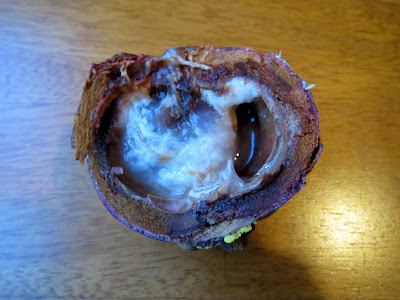I thought it was a nice touch to have Cristo Redentor guarding over the beer and wine.
My favorite part of the festival -- a huge selection of exotic fruits! Not only from Brazil, actually, but from all over the world.
We were able to taste eleven fruits for the first time.
Starfruit, also known as carambola, tastes similar to a pear but has a juicier consistency, more like a grape. The coolest thing about it, of course, is that it looks like a star when sliced.
This made it the favorite of Jackson and Olivia (besides kiwi fruit, which was not new to us, but we picked up a couple of them none the less because they are much-loved by my children.)
Fun fact: carambola is high in oxalic acid and should not be eaten by individuals suffering from kidney stones, kidney failure, or undergoing dialysis. But it's also high in antioxidants, potassium, and vitamin C, so it's great for those of us with healthy kidneys.
I thought the cactus pear got its name from its slightly prickly exterior, but it's actually the fruit of the opuntia cactus plant, and it also goes by the name of prickly pear. In Austin, prickly pear-flavored margaritas are popular at Tex-Mex restaurants, yet this was my first time trying the actual fruit. The pear is bright purple on the inside, tastes like a typical pear, and has a noticeable floral aroma.
Isn't this one cute? The heart-shaped cherimoya, or custard apple, is sweet not only in shape, but in flavor. Apparently, Mark Twain called it the most delicious fruit in the world.
I understand how it gets the "custard apple" nickname, as it has a creamy, custard-y texture. It tastes kind of like a banana mixed with a mango.
Guava is naturally high in pectin, so it is commonly made into jams and jellies. Guavas are also super healthy! They are high in fiber, low in calories, and contain four times the amount of vitamin C as an orange.
I think our guava was immature. When we cut into it, it was really tough and didn't have much flavor. Later I saw some guavas at the Asian market that were much bigger and had a darker green coloring.
The kiwano horned melon's exterior can only be described as freaky-looking.
Inside, edible seeds are coated in green gel. The taste is similar to cucumber. I liked this one a lot. Very refreshing.
The mamey is often made into milkshakes and ice cream. I recall seeing mamey paletas at Paleteria la Selva, but I didn't know what it was at the time.
According to Wikipedia, the fruit is considered by some to be an aphrodisiac.
I made a smoothie with mamey, almond milk, vanilla, stevia, and ice. It was delicious, sweet and creamy.
The mangosteen...we had an interesting experience with this one. When I looked it up online, pictures showed a white, fleshy fruit inside.
When Tony hacked it open, this is what we saw. I worried that it was rotten, but Tony dug right in and exclaimed how delicious it was. He said it tasted like banana yogurt. I hesitantly tried a spoonful of the goop, and he was right about the flavor, but it had a very tart, acidic note to it and I didn't want to eat anymore. Tony didn't get sick, though.
Passionfruit is the fruit of the passionflower. Passionflowers bloom in our front yard, but they don't produce fruit. Different variety, I guess. Passionfruit is high in vitamin A, vitamin C, fiber, and iron. And of course, as its name implies, it has also been considered an aphrodisiac.
I love the bold, tart flavor of the fruit. The seeds, however, are super crunchy. I think I'd rather drink passionfruit juice and get the flavor without the crunch.
Pepino melon, or pepino dulce, is actually not a melon, but a nightshade, a relative of the eggplant. However, it is ripe when it has a sweet smell on the stem end, just like a cantaloupe or honeydew melon. It has a mild flavor, kind of like a honeydew melon crossed with a pear.
Wikipedia warned us that quince is usually too hard, astringent and sour to eat raw. It is often roasted, baked or stewed. It has a lovely perfume scent.
I made quince-applesauce (recipe below).
Finally, dragonfruit. I feel like I saved the best for last because dragonfruit is such an awesome name. The fruit is also known as the pitaya, but that's not as much fun to say.
The fruit's texture is similar to kiwifruit, with tiny black crunchy seeds, but the flavor is mild.
Quince-Applesauce
4 apples (I used Gala)
1 quince
1/2 cup + 2 T water
2 t vanilla
1 t cinnamon
1 T cornstarch
2 droppers of liquid stevia
Core and finely slice the apples and quince, leaving peels on. Place in a soup pot with 1/2 cup water, vanilla and cinnamon, and bring to a boil. Reduce heat to low and cover, simmering for 20 minutes. In a small bowl, combine cornstarch with 2 T water. Add cornstarch mixture to the applesauce, stirring to thicken. Add stevia to taste, and serve.


























No comments:
Post a Comment